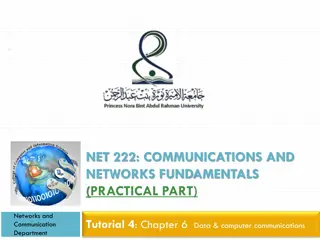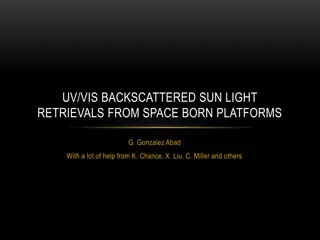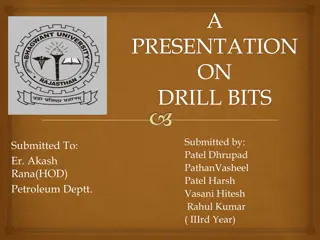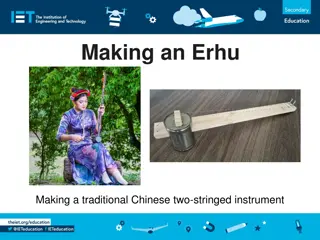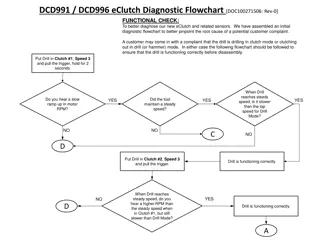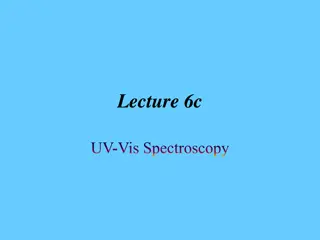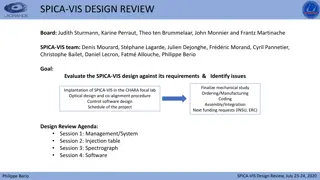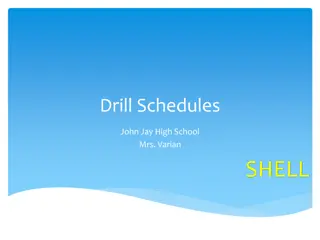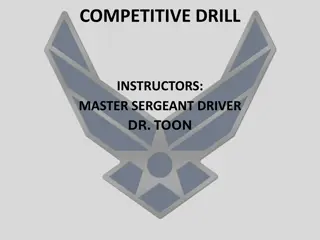
UV-VIS Instruments and Techniques Overview
Explore the functionality of UV-VIS instruments such as Lambda 4B and Lambda 25/35, understanding the optical path design, detectors, monochromators, and sources used, along with tips to improve resolution and maximize performance.
Download Presentation

Please find below an Image/Link to download the presentation.
The content on the website is provided AS IS for your information and personal use only. It may not be sold, licensed, or shared on other websites without obtaining consent from the author. If you encounter any issues during the download, it is possible that the publisher has removed the file from their server.
You are allowed to download the files provided on this website for personal or commercial use, subject to the condition that they are used lawfully. All files are the property of their respective owners.
The content on the website is provided AS IS for your information and personal use only. It may not be sold, licensed, or shared on other websites without obtaining consent from the author.
E N D
Presentation Transcript
Text website exercise: single beam double beam and multichannel instruments http://www.cengage.com/chemistry/book_content/049501201 7_skoog/student_website/as_ie1.html Use internet explorer to open
What gas is excited in the UV source of Both the Lambda 4B and Lambda 25/35 ? D2 (deuterium) What is the hyphenated name of the optical path design of the Lambda 4B UV-VIS ? Czerny-Turner What kind of monochromator is in the Lambda 4B instrument ? Echellette What produces the visible spectrum in both the Lambda 4B and Lambda 25/35 instruments ? Tungsten-Halogen bulb Extends the life of the tungsten (W(g) +I2 WI2 (g) W(s) + I2 (g) What does the halogen do in the above source ?
What is the key difference between the Spec 20 and either of our PE Lambda UV-VIS instruments ? Spec 20 is single beam Lambdas are double beam What component generates the double beam in the Lambda 4B ? Optical chopper Lambda 25/35 has no chopper What is the chief difference between the Lambda 25/35 and Lambda 4B ? What component allows the Lambda 25/35 to work without a chopper ? Focusing, concave, holographic monochromator
1)Focusing (better throughput) 2) Less dispersion (scattering) 3) Less spherical aberration Name two advantages of the holographic grating What kind of detector is in the Lambda 4B ?PMT (photomultiplier tube) What kind of detector is in the Lambda 25/35 and how many are there in each instrument ? The above detector is operated in `reverse bias for two reasons. What are they ? 2 Photodiode detectors (reference and sample) 1)Linear response to light flux 2)Lower capacitance=> faster response What role does the `color wheel play in our double beam instruments ? Removes unwanted light diffraction orders
If you need to increase the resolution of your uv- vis scan What two things can you change to achieve it ? 1)Slower scan rate 2)Smaller slits What determines the 180 nm cutoff for our Lambda 4b and 25/35 instruments ? Quartz cell absorption The Spec 20 has one advantage over our Lambda 4B and 25/35 instruments. What is it ? Higher light intensity=> larger net signal (single vs double beam) Which measure is linear with concentration, %T or A ? A (Absorbance)
What kind of transition occurs in our uv-visible instruments ? electronic Over what wavelength region does this occur in our instruments ? 180-1100 nm Why are solution phase absorptions broad and continuous ? Solvent interactions with absorbing species Gas phase atoms and molecules What kind of species produces discrete and narrow uv-vis absorptions ?
Drill and practice with UV-VIS technique (cont.) echellette echelle Correctly name the two designs of monochromators above Name of monochromator design shown to left Holographic (curved) grating
Drill and practice with UV-VIS technique (cont.) Provide two advantages provided by the holographic (curved) grating design No chopper simplifies optical path Simultaneous sample and reference measurement Lower spherical aberration The chopper rotation frequency is .: Tuned to, to improve resolution Used as the phase locking frequency that helps filter noise Improves light intensity if increased the Quadrature signal use to increase the PMT output
Drill and practice with UV-VIS technique (cont.) List all the ways you can think of to improve the resolution of a specific UV-VIS instrument 1. Slower scan 2. Smaller slit widths 3. Maximize analysis order (n) [this is usually not available on regular instruments Which is not a difference between the Lambda 4B and Lambda 25 instrument ? Lambda 4b Lambda 25 Chopper No chopper Echellette grating Holgraphic grating D2 and tungsten-I2 source One (1) PMT transducer Photo-emissive source 2 photodiode transducers Same source as Lambda 4b Mirrors + focusing lens optics Mirrors + beam split optics
1)ID the names of the two sources shown Drill and practice with UV-VIS technique (cont.) http://assets.newport.com/web600w-EN/images/1319.jpg http://shop.spectrecology.com/images/DH-2000-BD-deuterium-bulb-300x300.png 2)Which is for vis and which is for UV ? Tungsten-Halogen Deuterium lamp VIS UV What is the purpose of the halogen (I2) ?Improves life span What is the transducer in the Lambda 4B ? of W filament Photomultiplier tube (PMT) What is the transducer in the Lambda 25 ? Photodiode
Which is the PMT and which is the photodiode ? Drill and practice with UV-VIS technique (cont.) Silicon Inversion Layer PMT Photodiode What metal provides the low workfunction allowing a PMT to operate ? Cs (cesium) Dynode pairs Name of the PMT part that amplifies the original Photocathode current
Drill and practice with UV-VIS technique (cont.) In what part of the I-V curve is the Photodiode operated in UV-VIS Reverse biasing What is the technical name for this practice ? Provide two reasons this is done in the Lambda 25 UV-VIS instrument ? 1) Lower capacitance=> faster response 2) Current linear with photon flux




